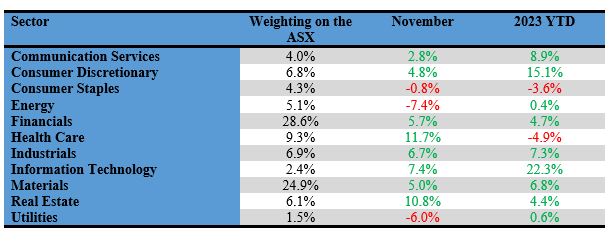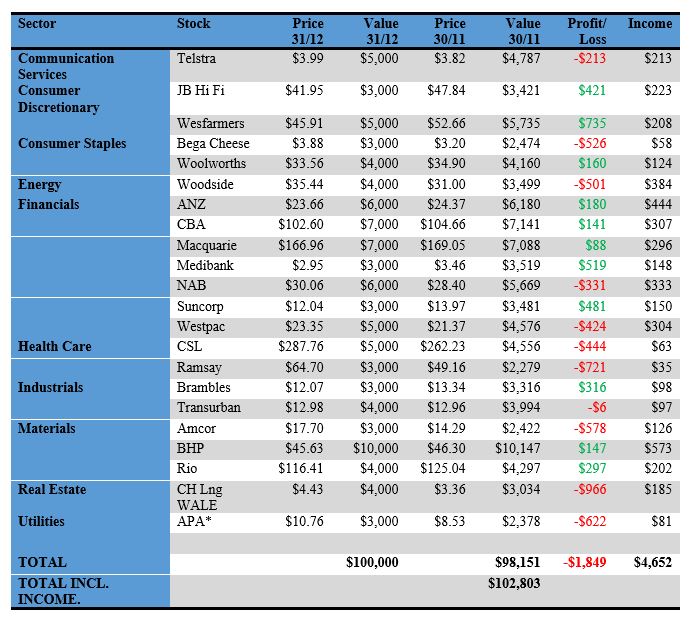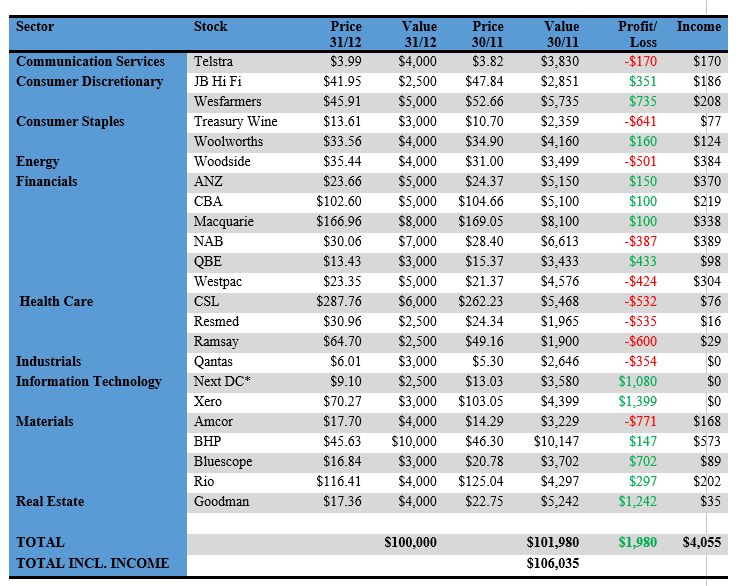The Australian share market couldn’t match Wall Street’s gains in November (the Dow Jones up by 8.8% and the NASDAQ 100 by 10.7%), but it did add 5% (when dividends are included). Our portfolios followed suit and are now firmly in the black.
There are two model portfolios – an income-oriented portfolio and a growth portfolio.
The objectives, methodology, construction rules and underlying economic assumptions can be referenced here: (see: https://switzerreport.com.au/our-portfolios-for-2023/
These are long-only model portfolios, and as such, they are assumed to be fully invested at all times. They are not “actively managed”, although adjustments are made from time to time.
In this article, we look at how they have performed so far in 2023. To do so, we will start by examining how the overall market has fared.
Health and real estate surge back as small caps gain favour
The tables below show the performances in November and for the calendar year of the components and industry sectors that make up the Australian share market.
Reversing the trend that has been in place for most of the year, small and midcap stocks outperformed the mega caps in November. The small ordinaries index, which tracks the performance of stocks ranked 101st to 300th by market capitalization, added 7.0% in November, 2% more than the benchmark S&P/ASX 200. Year to date, small caps and mid-caps lag the broader index, and have returned less than the “top 20” stocks. The latter, which is represented by the S&P/ASX 20 index, has returned 5.6% in 2023.
Market component performance

With the industry sectors, information technology is the standout sector. Following the lead from the USA, the sector posted a gain of 7.4% in November and is up 22.3% in 2023. Two sectors that have been under pressure due to higher bond yields, health care and real estate, starred in November adding 11.7% and 10.8% respectively.
The largest sector, financials, added 5.7% in November. Making up 28.6% by weighting of the broader S&P/ASX 200 index, the sector has returned 4.7% in 2023, broadly in line with the overall market. The second largest sector, materials, which includes the big miners such as BHP and Rio, matched the market in November and has marginally outperformed over the course of the year.
Consumer discretionary is perhaps the “surprise” sector of the year, given the negative commentary about consumers being stretched and higher interest rates taking their toll on consumer spending. Year to date, it is up by 15.1%.
The normally reliable and defensive sector, consumer staples, which includes names such as Woolworths, Coles, Endeavour, Metcash and Treasury Wines, is the second worst performing sector with a loss of 3.6%.
Industry sector weighting and performance

Portfolio performance in 2023
The income portfolio to 30 November has returned 2.8% and the growth-oriented portfolio has returned 6.04% (see tables at the end). Compared to the benchmark S&P/ASX 200 Accumulation Index (which adds back income from dividends), the income portfolio has underperformed by 2.01% and the growth portfolio has outperformed by 1.23%.

Income portfolio
The objective of the income portfolio is to deliver tax-advantaged income, whilst broadly tracking the S&P/ASX 200.
The income portfolio was forecast to deliver an income return of 5% (based on its opening value at the start of the year), franked to 80.3%. Year-to-date (11 months to end November), the income return is 4.65% franked to 80.9%. When final dividends are received from Transurban, APA and Charter Hall Long WALE REIT, this forecast should largely be met.
In the month of November, the income portfolio returned 4.4%, underperforming the benchmark index by 0.63%. Telstra, Woolworths, Woodside and Ramsay Health Care weighed on an otherwise solid performance. Year-to-date, the portfolio has returned 2.8%, underperforming the benchmark index by 2.01%.
The portfolio is moderately overweight financial stocks and underweight the more growth-oriented sectors such as information technology and health care. In a strong bull market, the income portfolio will typically lag the market, and in a bear market, it’s likely to outperform.
No changes to the portfolio are proposed at this point in time.
The income-biased portfolio per $100,000 invested (using prices as at the close of business on 30 November 2023) is as follows:

* Portfolio unable to participate in APA capital raising at $8.50 per share
Growth portfolio
The objective of the growth portfolio is to outperform the S&P/ASX 200 market over the medium term, whilst closely tracking the index.
In November, the growth portfolio returned 4.04%, underperforming (on a relative basis) the benchmark index by 0.99%. While most stocks traded higher, Treasury Wines (which undertook a rights issue), Xero, Woodside and Woolworths fell. Year-to-date, the portfolio has returned 6.04%, outperforming the benchmark by 1.23%. (Note: performance does not include potential participation in NextDC 1:8 non renounceable entitlement issue at $10.80 per share).
The portfolio is moderately overweight financials, health care and information technology. It is moderately underweight industrials, real estate and utilities. Overall, the sector biases are not strong.
No changes are proposed to the portfolio at this point in time.
Our growth-oriented portfolio per $100,000 invested (using prices as at the close of business on 30 November 2023) is as follows:

* Performance does not include participation in 1:8 non-renounceable issue at $10.80 per share
Important: This content has been prepared without taking account of the objectives, financial situation or needs of any particular individual. It does not constitute formal advice. Consider the appropriateness of the information in regards to your circumstances.

